Red Bean Rice with Chestnuts (Kuri Okowa) is a luxurious version of Rice with Azuki Beans (Osekihan). It is one of the representative autumn rice dishes in Japan because of the harvesting time of chestnuts.
It’s so happened that school sports carnival in Japan is often held in autumn that family of the school children come and watch the competitions and activities, bringing bento boxes with Kuri Okowa in it.
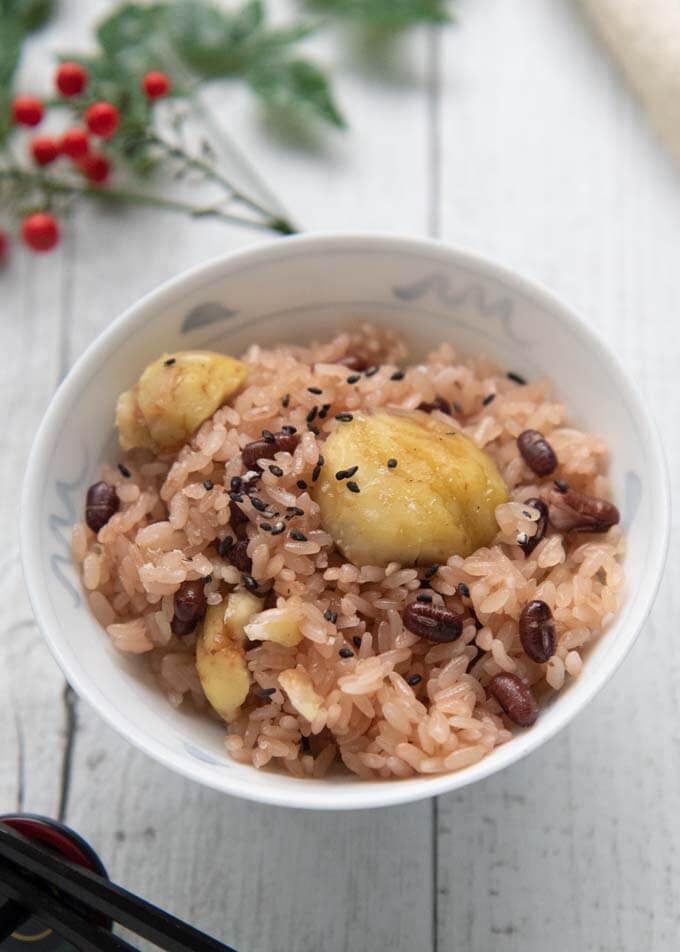
The contrast between the red rice and the yellow chestnuts is so pretty and makes it a perfect dish for happy occasions just like Osekihan. Given that chestnuts are available only in autumn, it makes today’s dish more special.
I have a fond memory of chestnuts. My father is from Ibaraki prefecture which ranks no. 1 in chestnuts production. His parents were farmers and had a huge mountain full of chestnuts trees.
My father became a teacher in Tokyo instead of taking over his father’s business. But in every autumn, he took us kids to his parent’s home to pick chestnuts in a pointy sea urchin-like shell. It really fascinated me to see beautiful shiny chestnuts inside the shell covered with needles.
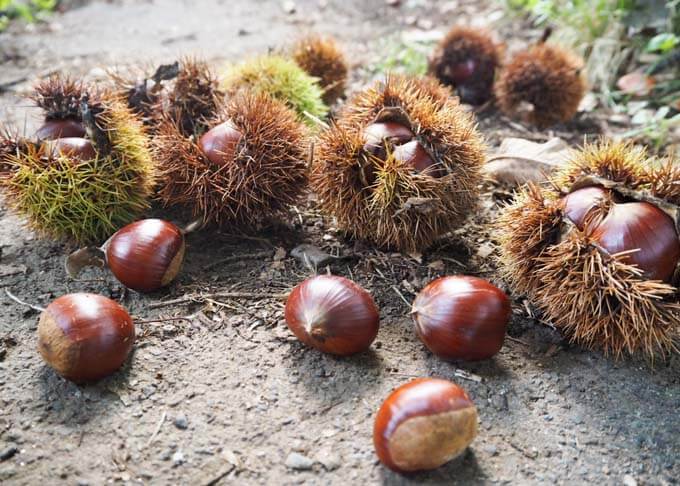
Two Types of Kuri Okowa
I put down ‘Kuri Okowa’ (栗おこわ) as a Japanese name for Red Bean Rice with Chestnuts, but it’s not 100% accurate. Because the word ‘okowa’ (おこわ) means cooked glutinous rice and ‘kuri’ (栗) means chestnut.
So, the rice does not have to be red with azuki beans. In fact, there are a white version of Kuri Okowa and a red version of Kuri Okowa.
If you Google search ‘栗おこわ’, most recipes are just glutinous rice with chestnuts in it. Peel chestnuts, place them on the washed glutinous rice, and cook in the right amount of water with a small amount of salt and cooking sake. Sometimes they are steamed, instead of cooked in a pot or a rice cooker.
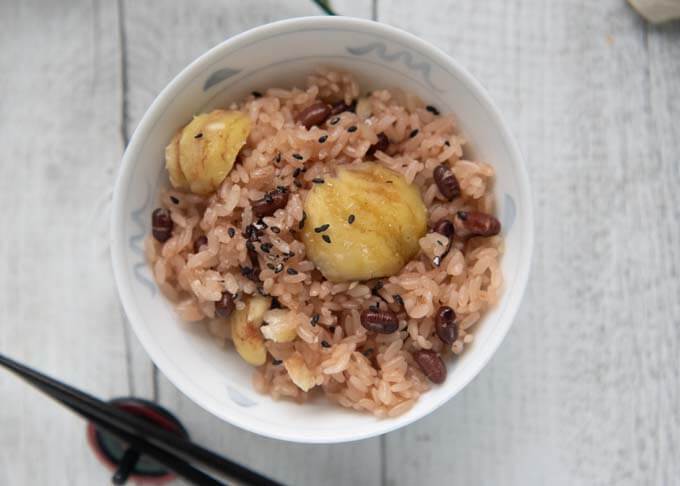
Since my Red Bean Rice with Chestnuts is made of glutinous rice, the cooked rice can also be called okowa even if it is red and has azuki beans in it. Google search will bring up a few red Kuri Okowa among white Kuri Okowa.
What’s in my Red Bean Rice with Chestnuts (Kuri Okowa)
The ingredients are basically the same as Rice with Azuki Beans (Osekihan), with addition of chestnuts.
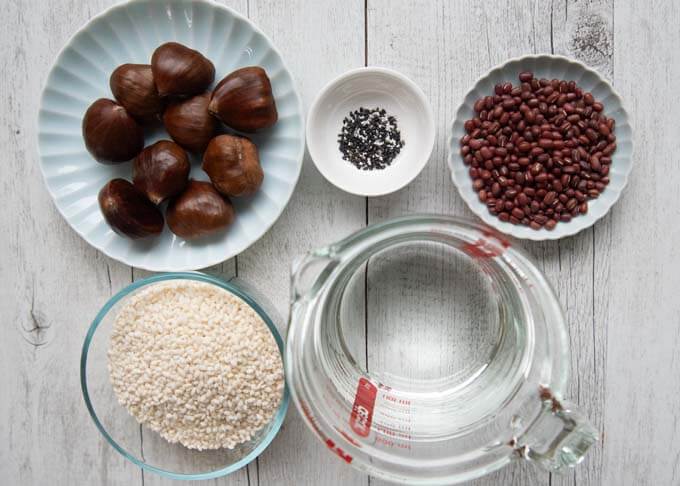
- Sticky rice/glutinous rice
- Dried azuki beans
- Chestnuts
- Water
- Gomashio for serving
Gomashio is sprinkled over Kuri Okowa almost by no exception. The salt goes so well with sweet chestnuts.
How to make Red Bean Rice with Chestnuts (Kuri Okowa)
You can actually follow the instruction for Rice with Azuki Beans (Osekihan). The only additions are peeling chestnuts and putting them on the rice.
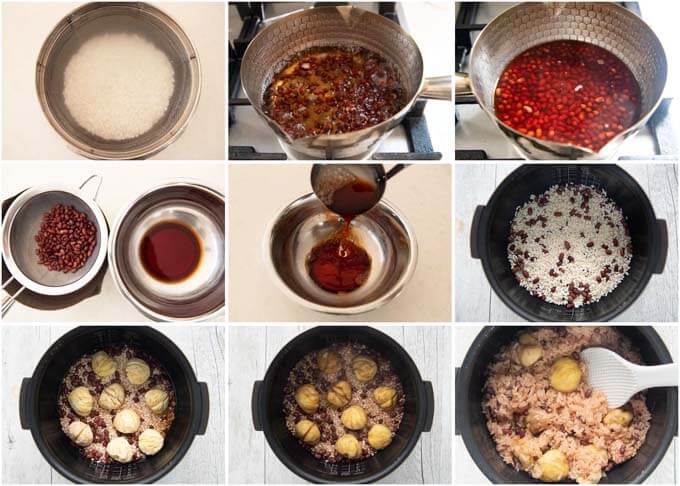
- Peel chestnuts (refer to the subsequent section for peeling chestnuts) and leave them in water for 1 hour. This will remove the harsh taste from the chestnuts.
- Wash and soak glutinous rice in water for at least 30 minutes to let it absorb water. Drain.
- Boil azuki beans in a saucepan for about 20 minutes to al dente.
- Separate the beans and liquid into bowls.
- Scoop the liquid with a ladle and pour it back gently into the bowl, allowing the red colour of the liquid to intensify.
- Place the rice and beans in a rice cooker, mix, then add red liquid to the water level required for sticky rice.
- Drain chestnuts and scatter them on the rice, then cook.
How to Peel Chestnuts
Removing the hard and soft skin of fresh chestnuts using a knife is quite an effort. This is because chestnut flesh is tightly covered in a thin hairy skin inside the very hard brown shell.
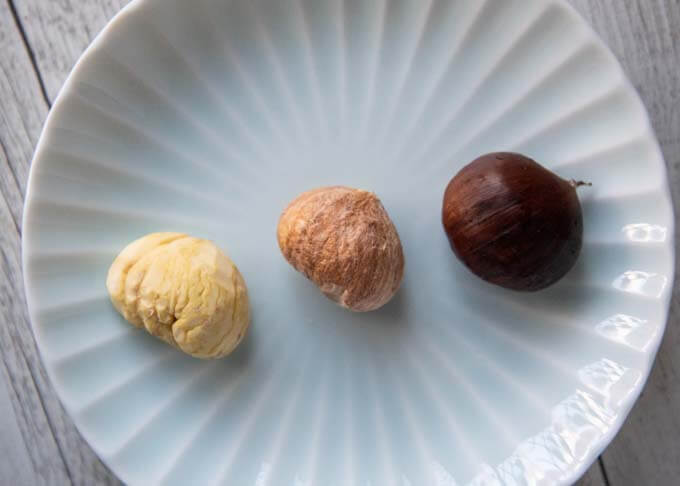
I tried two different methods to peel my chestnuts, which I described below. There are pros and cons in both methods.
The first method is how my father taught me to peel the hard shell and soft skin. This is a laborious way of peeling chestnuts, but the end results are superior.
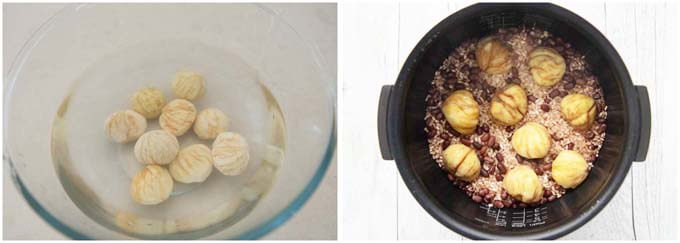
The second method works like a magic. You make an incision on a chestnut and cook slightly to let the incision open up. The hard and soft skins come off easily at once. However, the cooked chestnuts do not look as attractive as the first method due to the discolouration.
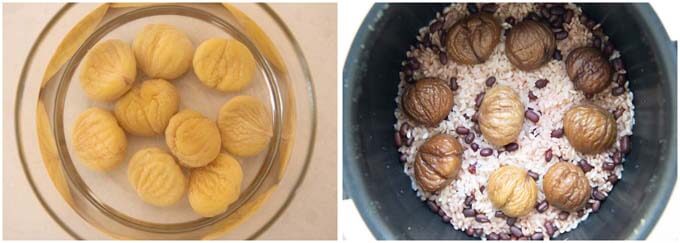
Method 1 :
- Soak chestnuts in water for a couple of hours.
- Take one chestnut at a time from the water and peel the bottom of the chestnut using a knife, slightly revealing the flesh.
- Starting from the bottom part of the hard shell, which is now showing the flesh, peel the hard shell upwards piece by piece.
- You should now see a chestnut with soft skin intact.
- Put the chestnut back in the water.
- Repeat above for the rest of the chestnuts.
- Take one chestnut from the water and peel the soft skin using a knife.
- Soft skin is sometimes embedded in narrow vertical cracks. Make a v-cut using a knife along the crack and remove the soft skin.
- Put the peeled chestnuts back in the water.
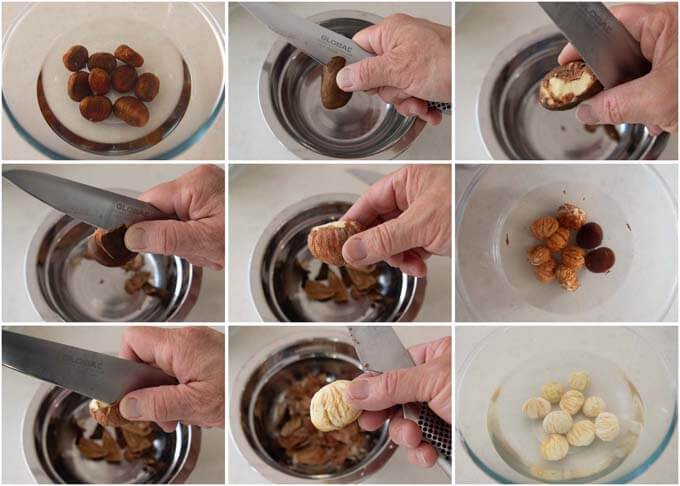
Method 2:
The secret is to make an incision on the skin and let the incision open up. Here is how:
- Make a horizontal incision on the round side of chestnut. The incision needs to reach to the soft skin.
- Put the chestnuts in a pot of water and boil them for a couple of minutes. You will notice that the incision starts opening slightly.
- Drain and place them on a kitchen towel to remove moisture around them.
- Place the chestnuts in the pot and heat over high heat for a minute or so, with a lid on. The chestnut skin dries, and the incision opens up further.
- Turn the heat off and transfer the chestnuts onto the kitchen towel.
- Take one chestnut at a time, hold the chestnut positioning the incision vertically, facing up, positioning the incision vertically.
- Using your thumbs, open the incision by pulling the shell outwards. It should peel the shell as well as the soft skin.
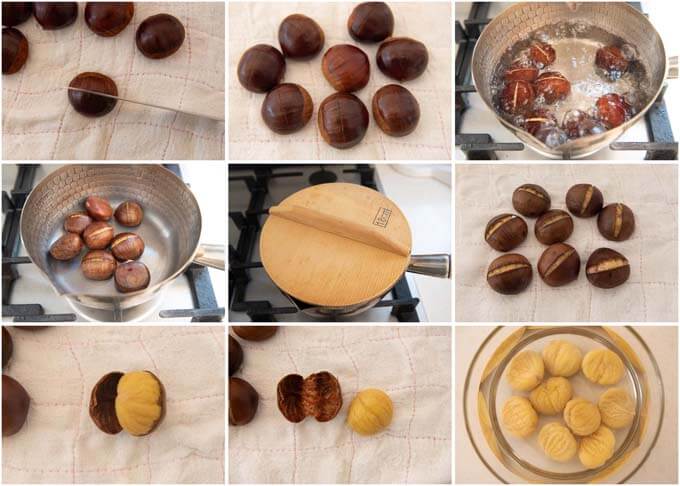
The skin peels like a charm. If hairy thin skin is stuck to the flesh, which happens when the chestnuts are still moist, use a knife to peel it off. It is important to peel the shell and skin while the chestnuts are still hot or at least warm.
Sometimes, the soft skin runs in the middle, dividing the flesh into two when peeled. That’s OK as the chestnuts will break anyway when mixed with rice before serving.
Because the surface of the peeled chestnut is slightly cooked, it become brownish when cooked with rice.
Chestnuts are seasonal food, and you can still buy them at vegetable shops and supermarkets in Australia at the moment. I hope you try Kuri Okowa while it is in season.
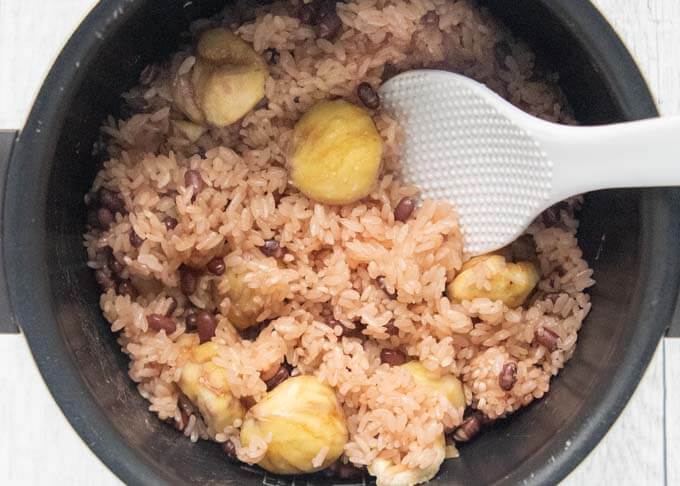
Yumiko![]()
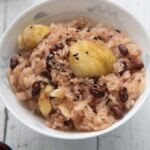
Red Bean Rice with Chestnuts (Kuri Okowa) is a luxurious version of Rice with Azuki Beans (Osekihan). The contrast between the red rice and the yellow chestnuts is so pretty and makes it a perfect dish for happy occasions just like Osekihan.
I included two methods of peeling chestnuts. The first method takes time, but the cooked chestnuts retain bright yellow. The second method let you peel the skins easily, but the colour of the cooked chestnuts is not attractive. There is no difference in the flavour of the dish.
Total Time is based on Method 1.
Don't forget to see the section 'MEAL IDEAS' below the recipe card! It gives you a list of dishes that I have already posted and this recipe that can make up a complete meal. I hope it is of help to you.
- 2 rice cups glutinous rice (360ml/0.8pt)
- 150-200g/5.3-7.1oz chestnuts
- 50g/1.8oz dried azuki beans
- 500ml/1.1pt water
-
Soak chestnuts in water for a couple of hours to soften the hard shell.
-
Take one chestnut from the water and peel the bottom of the chestnut using a knife.
-
Starting from the bottom part of the hard shell, which is now showing the flesh, peel the hard shell upwards piece by piece. You should now see a chestnut with soft skin intact.
-
Put the chestnut back in the water. Repeat above for the rest of the chestnuts.
-
Take one chestnut from the water and peel the soft skin using a knife. Put peeled chestnut back in the water.
-
Soft skin is sometimes embedded in narrow vertical cracks. Make a v-cut using a knife along the crack and remove the soft skin.
-
Make a horizontal incision on the round side of chestnut (note 2). The incision needs to reach to the soft skin.
-
Put the chestnuts in a pot of water and boil them for a couple of minutes. You will notice that the incision starts opening slightly (note 3).
-
Drain and place the chestnuts on a kitchen towel to remove moisture around them.
-
Place the chestnuts in the pot and dry roast over high heat for a minute or so, with a lid on. Shake the pot from time to time. The chestnut skin dries, and the incision opens up further.
-
Turn the heat off and transfer the chestnuts onto the kitchen towel.
-
Take one chestnut at a time, hold the chestnut positioning the incision vertically, facing up.
-
Using your thumbs, open the incision by pulling the shell outwards. It should peel the shell as well as the soft skin (note 4).
-
As you peel chestnuts, place it in a bowl filled with sufficient amount of cold water to submerge them.
-
Leave the chestnuts in the water for 1 hour to remove the harsh taste them.
-
Wash rice and soak in water for at least 30 minutes. Drain using a sieve.
-
Wash azuki beans and transfer to a saucepan with water (not in ingredients) just to cover the beans.
-
Bring it to a boil, then drain the water.
-
Add 500ml water to the pan with azuki beans and bring it to a boil over high heat.
-
Reduce heat to medium to medium low and cook for about 15-20 minutes until the beans are cooked to al dente (note 5). Remove scum (white bubbles) from time to time while cooking.
-
Drain and keep the beans in a sieve and the red liquid in a bowl.
-
Scoop the liquid in the bowl with a ladle and pour it back gently into the bowl 4-5 times, allowing the liquid to be exposed to air (note 6). This will brighten the red colour of the liquid. Let it cool to room temperature.
-
Mix rice and azuki beans in a rice cooker. Add the red liquid to the level required for sticky rice/sweet rice. Add water if not enough red liquid.
-
Drain the chestnuts and place them on the rice and turn the switch on.
-
Mix azuki beans and rice in a heavy-bottomed pot, then add 300ml of the red liquid to the pot. Add water if the red liquid is not enough.
-
Place the lid on and cook over high heat for 5-6 minutes until it starts boiling.
-
Then reduce the heat to low and cook for 12-13 minutes until the liquid evaporates.
-
Turn the heat off and leave for 10 minutes.
-
Mix the rice and chestnuts gently using a spatula, breaking the chestnuts into half or quarter pieces (note 7).
-
Serve with gomashio either sprinkled over the rice or in a separate container for individuals to sprinkle.
1. There are pros and cons in both methods. Method 1 is a laborious way of peeling chestnuts, but the end results are superior. Method 2 peels the skins like a charm, but the cooked chestnuts are brownish. They both taste great, though.
2. Press the blade of your knife down on the shell and shift the cutting position to make an incision, rather than using a slicing motion. I find that pressing method is easier and safer. It cuts the shell better.
3. If your chestnut does not open after started boiling, it is probably because the incision is too shallow. You can take it out of the water and make the incision deeper, then put it back into the boiling water.
4. Do this while the chestnuts are still hot or warm. When they cool down, peeling becomes difficult.
5. The centre of the bean is a tiny bit hard. This is because the azuki beans are further cooked with rice.
6. Use a fan to send more air to the liquid if you want.
7. some of them break into smaller pieces while mixing. That's quite alright.
8. Nutrition per serving, not including the garnish, gomashio.
serving: 206g calories: 296kcal fat: 0.9g (1%) saturated fat: 0.2g (1%) trans fat: 0.0g polyunsaturated fat: 0.3g monounsaturated fat: 0.1g cholesterol: 0mg (0%) sodium: 43mg (2%) carbohydrates: 66g (24%) dietary fibre: 2g (7%) sugar: 0.8g protein: 5g vitamin D: 0mcg (0%) calcium: 20mg (2%) iron: 1.4mg (8%) potassium: 259mg (6%)
Meal Ideas
A typical Japanese meal consists of a main dish, a couple of side dishes, a soup and rice. I try to come up with a combination of dishes with a variety of flavours, colours, textures and make-ahead dishes.
I think fish goes very well with Kuri Okowa in general. A fried dish such as Mackerel Tatsuta Age would be great. But if you prefer meat, I recommend Karaage Chicken.
For side dishes, I picked a simmered dish and a light vegetable dish. I think clear soup goes better with Rice with Azuki Beans.
- Main: Marinated and Deep-fried Mackerel (Mackerel Tatsuta Age) – or Japanese Fried Chicken (Karaage Chicken).
- Side dish 1: Simmered Kiriboshi Daikon (Dried Shredded Daikon) – make ahead.
- Side dish 2: Tataki Kyuri (Smashed Cucumber Salad) – or other light vegetable dish.
- Soup: Dried Tofu Skin Soup – or other clear soup such as Roasted Seaweed Soup (Nori Sui).
- Rice: Red Bean Rice with Chestnuts (Kuri Okowa) – today’s recipe.
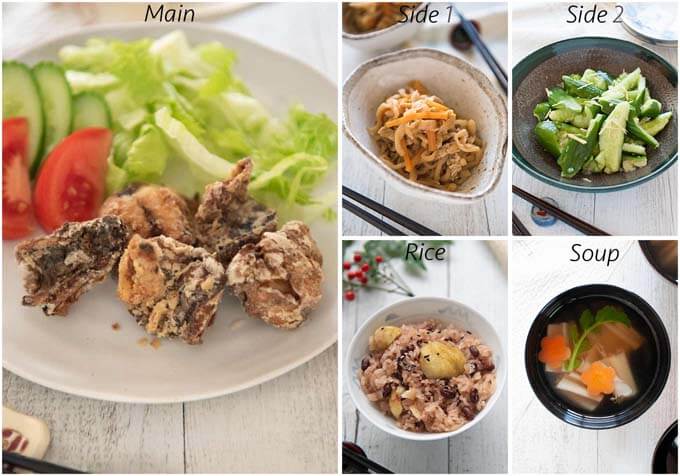
Thank you Yumiko.
I am so pleased to have a savoury option for the Azuki beans, as much as I love the sweet paste I think these recipes will get more use. Also, the meal recommendation is incredibly helpful. I often wonder what to do. Finally, I have a jar of roasted and peeled chestnuts. Do you think I could use them instead of fresh chestnuts? If so, how best to use them?
Warmly
Lee
PS we had Nagi’s Japanese fish last night, delicious! Perhaps she learned this from you? 🙂
Hi, Lee. Yes, you can use your roasted peeled chestnuts in place of peeled chestnuts.
As Nagi publicly stated, she never learnt cooking from me as she was too busy enjoying her own life.😅 But she sometimes gets the idea from the Japanese dishes I made and makes some changes to suit to her palate.